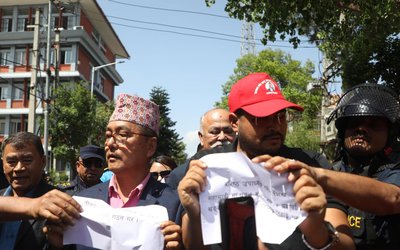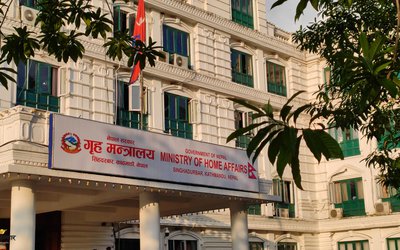
Amid the COVID-19 pandemic, a huge crowd is expected and we are working to manage a fine parking facility and a good place for devotees to sit. Also, as many devotees show eagerness to distribute food to the people present there, we are trying to manage a proper place for the devotees to enjoy their meal.
As Maha Shivaratri is mainly related to the night, the devotees stay up all night and pray to Lord Shiva. The four Prahars of Puja is carried out all night long, the devotees usually stay in tents along the Gaushala road.
Maha Shivaratri is known as one of the most celebrated religious festivals for Hindus. Every year Hindus from all over the world are seen thronging many Shiva temples during this festival. Pashupatinath Temple is the place with the biggest crowd on this day.
This year, on the occasion of Maha Shivaratri, the Pashupati Area Development Trust (PADT) is expecting a crowd of 1.3 million people from across the world. For the successful celebration of the festival, the management unit in Pashupatinath has started cleaning the area. Also, this year more importance has been given for figuring out an easier way to manage the crowd so that devotees can carry out their Puja and Darshan faster and more conveniently.
Spring is one of the best times to visit Nepal, and Indian tourists enjoy visiting during the most auspicious occasion of Maha Shivaratri. Special provisions are made to ease Darshan for Indian pilgrims at Pashupatinath during Maha Shivaratri, which falls on March 11 this year, according to officials at the Pashupati Area Development Trust (PADT). The PADT will also make available Pashupati Darshan passes at easy outlets near the Pashupati area to facilitate pilgrims from India.
Apart from Puja and Darshan other attractions for visitors to the temple vicinity at the time will be the colorful crowd including gorgeous Sadhu Babas from different parts of Nepal and India. People come to Pashupatinath to observe and see the different kinds of Sadhu Babas and their activities; some Sadhus are covered is ashes while some prefer to be completely naked.
Maha Shivaratri is celebrated marking the convergence of Shiva and Shakti. Maha Shivaratri also celebrates the night when Lord Shiva performed the "Tandav", the cosmic dance.
Hundreds of thousands of devotees visit Pashupatinath Temple in Kathmandu, one of the holiest shrines of the Hindus. Pashupatinath is considered the Guardian and Protector of the Kathmandu Valley and Nepal.
Devotees chant “Om Namah Shivay” and “Mahamritunjaya” all night praying for light over darkness. Tourists are seen enjoying the ambiance with curiosity, as colorful and naked sadhus are seen meditating, posing for photographs and interacting with disciples.
Special attendance camps are set in the courtyards of the temples. Children are seen collecting donations from passersby on this day preparing for holy meal and bonfire in celebration of the special night.
Hindus in Nepal celebrated their biggest festival Maha Shivaratri on Monday by offering prayers to Lord Shiva, who is regarded as the God of immense power and destruction.
Shivaratri is celebrated annually in the devotion of Lord Shiva on a new moon day in the Nepali lunar month of Falgun.
Devotees from across Nepal and other countries such as India, Malaysia and Singapore gathered in the holy shrine Pashupatinath Temple, a World Heritage Site of the United Nations Educational, Scientific and Cultural Organization (UNESCO), in Kathmandu for the special prayers.
On this day, devotees offer milk and flowers, especially "Dhaturo" (an intoxicating plant) and green leaves named "Belpatra" to Lord Shiva and light the oil lamps. People also observe fast and meditation on this day, while light woods and bonfires during the night and perform special prayers.
There are various myths behind the marking of Maha Shivaratri, among which the marriage of Lord Shiva with Goddess Parvati is one of the major reasons for celebration.
One of the major attractions of the Shivaratri festival in the holy shrine Pashupatinath is the visiting sadhus (sages) from within the country and neighboring India.
According to Pashupati Area Development Trust, this year around 7,000 sages of various clans have thronged the temple.
Besides prayers and devotion, the visiting sages with unique appearances are mostly seen getting intoxicated with local drugs. They engage in smoking weed, locally known as "Ganja" referring to the sacred Prasad of Lord Shiva.
Though the use of drugs is illegal in Nepal, the sages are often found mixing up some tobacco, marijuana and other cannabis-derived compounds and inhaling. The holy men believe that consuming marijuana enables them to overcome all the miseries and complexities of life.
Another aspect of the Shivaratri festival is the visiting Naga Babas who avoid all the clothes and cover the body only with ashes. These naked sages remain inside the main corridor of the temple for three days in the devotion of Lord Shiva.
- Iran, US to continue talks for nuclear deal
- Apr 20, 2025
- Putin announces Easter ceasefire in Ukraine
- Apr 20, 2025
- ICIMOD Says Hindu Kush Himalaya (HKH) Faces Lowest Rainfall In Third Conseqquetive Year
- Apr 19, 2025
- Tatopani Border Point Will Be Upgraded: Foreign Minister Dr. Deuba
- Apr 19, 2025
- Zelenskyy accuses China of supplying weapons to Russia
- Apr 19, 2025















